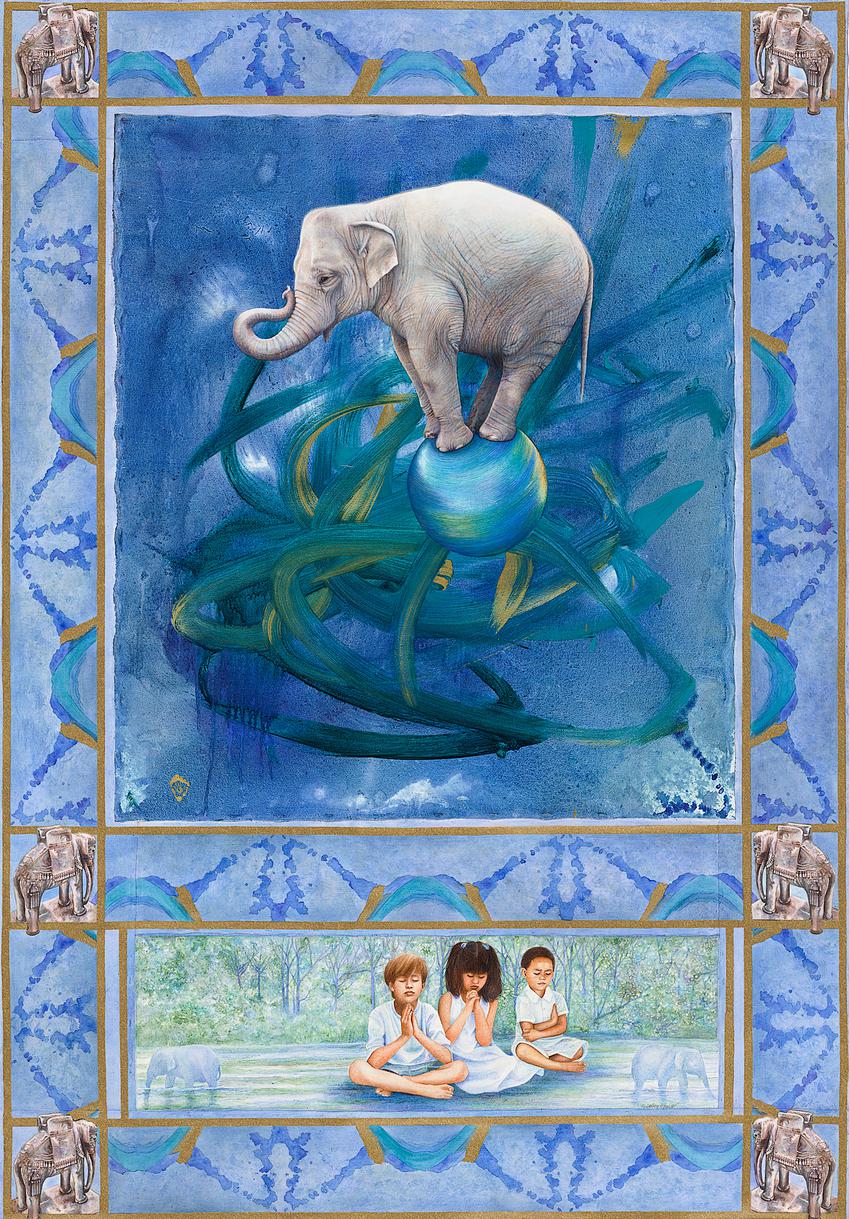ROSE'S DREAM
 | ||||
An International Traveling Exhibition
by Calley O'Neill and the Rama Team, Featuring Rama, the Artist Elephant
A JOURNEY OF ART AND SOUL FOR THE EARTH
Grazing elephants maintain the savannas and grasslands, preventing them from turning into forests. Elephants create water holes in dry riverbeds that in turn support a whole community of species. Elephants spread seeds. They make pathways that act as firebreaks and rainwater conduits, and their disturbance in the soil reveals amphibians, reptiles and insects for birds to eat.
In 1879, the Elephants Preservation Act was passed in India, protecting all elephants from harm, with the sole exception of a person’s self defense. This act honored the service that elephants have provided to humankind over many centuries. So it is not just other species that benefit from elephants, we have long been served by elephants’ power, energy and cooperation. Elephants actually respond favorably to agriculture, logging and bamboo harvesting if operated at a sustainable yield level with the early successional forest preserved. Thus, elephants are compatible with the long-term sustainable cultivation of forests.
In cultures around the world, elephants have long been charismatic animals, symbolic of wisdom, peace and power. Elephants are revered for their memory, high intelligence, sonic communication over great distances, and complex social and emotional behaviors, including grief, compassion, tolerance and social openness, altruism, and self-awareness. Really, elephants never forget.
Asian Elephants are at a high risk of extinction in the wild. Asian Elephants are in much more precarious situation than African elephants. The primary threats are: conflicts with humans, primarily in the rapid and severe loss of habitat from development, human population growth and the expansion of large-scale commercial agricultural operations, especially palm oil plantations, creating serious conflicts with farmers. The males are poached for their tusks.
Asian Elephants live in five Biodiversity Hotspots: Himalaya, Indo-Burma, Mountains of Southwest China, Sundaland, Western Ghats and Sri Lanka.
RAMA: AMBASSADOR FOR THE ENDANGERED ONES
Speaking Passionately on Behalf of Those who Cannot Speak
ASIAN ELEPHANT (ELEPHAS MAXIMUS)
STATUS: IUCN Red List and US Federal List, Endangered - CITES l
Listed as endangered since 1996 due to population reduction of at least 50% over the last three generations (60 – 75 years) There is little accurate data on historical population size. Asian elephants population trends are decreasing due to poaching for the ivory trade and the most grave threat: ongoing habitat loss, degradation and fragmentation due to agriculture and deforestation, which causes human/elephant conflicts. Ancient migratory routes are cut off, causing risks of inbreeding. Elephants are protected internationally against poaching and trading and there are many conservation efforts under way.
This, the first Calley and Rama collaborative painting, depicts Rose, Rama’s sister. When Calley took the reference photograph, Rose was pregnant with the baby bull Samudra, yet no one knew it at the time.
The biggest, most powerful and one of the most charismatic animals on Earth, Asian Elephants stand 7 to 12 feet tall and weigh between 6,000 and 15,000 pounds, reaching their maximum size at about 25 years old. From trunk to tail, they can be 30 feet long. They achieve this by spending as much as 18 – 20 hours a day feeding. They are highly regarded as a keystone species, a species that plays a critical role in maintaining the structure of an ecological community. A keystone species’ contribution to the community is vital in maintaining the ecosystem’s health and balance.
Long live the elephants! Long live the elephants! Long live the elephants! Long live the elephants!
by Calley O’Neill and Rama the Elephant with Jeb Barsh








